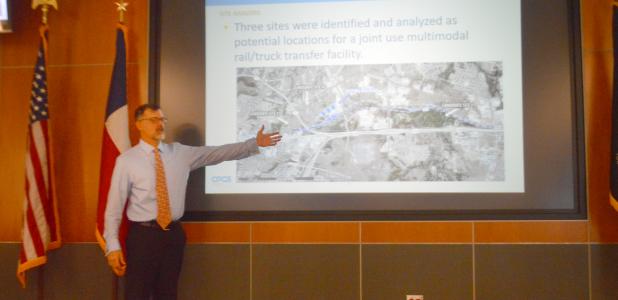Stakeholders, local reps get update on Fort Hood joint use rail/truck transfer facility study
By LYNETTE SOWELL
Cove Leader-Press
The future of a possible joint use rail/truck transfer facility on Fort Hood that could be used by both the military and the private sector was the topic of a Tuesday morning workshop held at the Copperas Cove Police Department community room.
Local stakeholders received an update on a feasibility study being conducted by CPCS Transcom. The bulk of the $300,000 feasibility study is being paid for by the Department of Defense, with Coryell County and the Copperas Cove Economic Development Corporation kicking in $15,000 apiece as a 10 percent match.
Coryell County judge John Firth talked about CPCS Transcom and the work being done on the study.
“They are a quality team that really understands the rail industry and transportation overall, I don’t know of any other consulting company in the country that knows as much about rail as they do,” Firth said.
Right now, the study’s focus is if the regional market is there in the private sector to use the facility.
“How do we try to get the maximum civilian commercial benefit from this, maybe not necessarily in the rail business itself, how do we benefit and leverage this to the nth degree, and really increase the tax base within the community?” Firth told those present. “That’s what this is all about, increasing the tax base so we can take some pressure off the property taxpayers and ultimately creating jobs. If we can do that at the same time Fort Hood realizes an increase in terms of their surge capacity, it would support their strategic military mission.”
Patrick Anater with CPCS Transcom said the local “catchment” area is contained within a five-hour drive of the area, for short haul truck driving.
“We are looking at day truckers, with a limit of five hours’ drive time,” Anater said.
He said they’re taking steps now to identify the market demand for the rail facility, as well as commodities that would be transported from the facility, as well as the types of businesses that would use the facility.
“From here on out, what we’re going to do is make sure we fact check with potential users, include costs of infrastructure improvements, as well as revenue projections,” Anater said.
He said that TxDOT has a database of commodities transported within the state of Texas and they are identifying which of those are rail oriented and could be potentially transported from that joint use facility.
“This not high-value things that won’t go by rail. This is your bulk commodities, liquid as well as building materials, heavy things that aren’t necessarily high value.”
They are also working to determine origins and destinations within the five-hour catchment area.
Among the top commodities is sand, primarily fractionation sand for fracking, followed by bulk commodities from the mining sector. Anater said there are a few “holes” in the catchment area, particularly near Fort Worth and the Houston area, with transload facilities already being used in those areas.
“We are looking to the Austin and San Antonio areas as possible customers for the facility,” he added.
“Fort Hood really wants a facility for surge capabilities,” Anater said. “Under major deployments, it needs excess capacity to move things. If Fort Hood wants this facility and wants to allow the private sector on it, they could do it right now.”
Firth expressed that the key to the study is to convince the ones authorizing and then funding the project – Congress and the Department of Defense – that the need would be justified.
“For the Department of Defense and ultimately Congress to allow money for this facility, it has to be justified not only for the surge requirement for Fort Hood, but from an economic standpoint for our country, how does the country, how does the region benefit?
“What we’re trying to do here is justify within the catchment area here that there would be enough demand for the money decisionmakers to support this, understanding that the demand is there. The catch for us, for Copperas Cove and Lampasas, what new businesses would come in and be here? This would mean and additional payoff in terms of jobs and tax base.”
Anater said CPSC Transcom expects to have a draft of the study prepared by mid November, to present to Firth.
The completion deadline for the study is Dec. 15.

